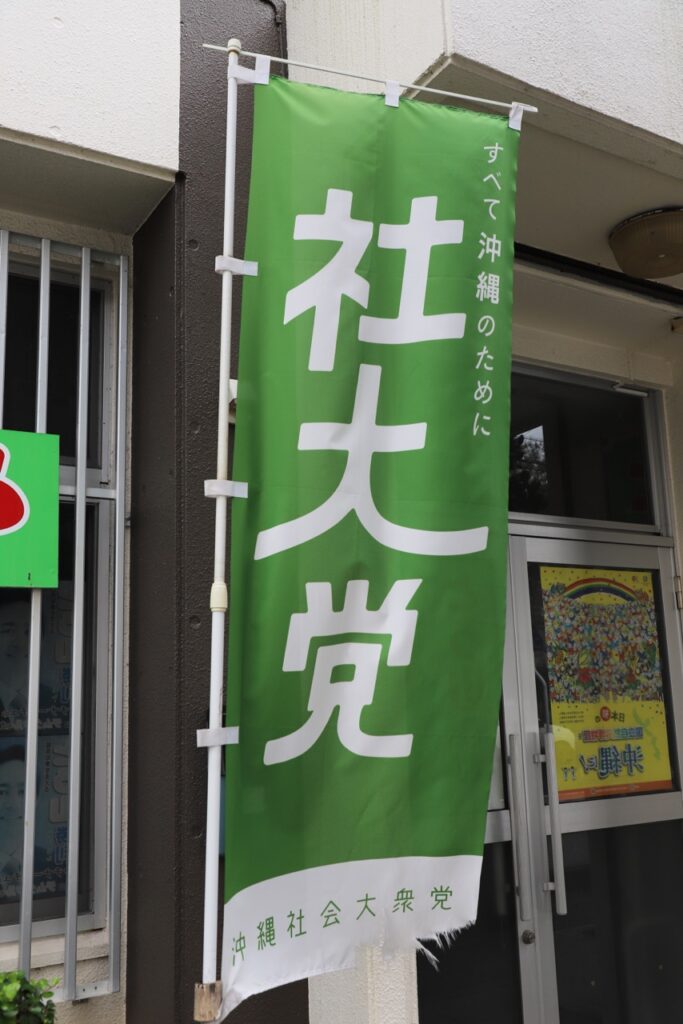The Shadai Party

More properly the Okinawa Shakai Taishū-tō (Okinawa Social Mass Party), this political party has no relation to the Shakai Taishū-tō (Socialist Masses Party), which was active prior to WWII.
There are 713 seat total in the bicameral Japanese Diet, and only one is proudly held by the Shadai Party. Party membership is Uchina bikēn—Okinawan only—and it’s rare for a local prefectural party like this one to gain a seat in the Diet. Japan has many political parties: Jimin-tō (the Liberal Democratic Party), Rikken Minshu-tō (the Democratic Party), Kōmei-tō (the New Kōmeitō), Kyōsan-tō (the Communist Party), Shamin-tō (the Social Democratic Party), and more. However, given that most of these don’t hold seats while the Shadai does, perhaps the Shadai should be considered one of the major political parties.
The Shadai Party was established in 1950 with humanism as its party philosophy. Party politics in postwar Okinawa under US military rule revolved around the Shadai Party, which then split into different factions. Many politicians in Okinawa have been influenced by connections with the Shadai Party, breaking away from and reuniting with the party in waves. Its warp and weft are built on collectivism and it has served to nurture numerous Okinawan politicians. Every ten years, the party holds an anniversary celebration of its founding, which naturally provides both progressive and conservative politicians of Okinawa an opportunity to gather.
After its founding, the party’s main goal was Okinawan Reversion to Japan. When that was achieved in 1972, party members were divided over whether the party should be dissolved or incorporated into the Japanese political party system, but in the end, they chose to become an indigenous political party. The return of Okinawa to Japan was a drastic change that completely overturned the existing values, and out of this confused state of affairs, the Shadai Party chose to walk its own path. Former Governor Taira Kōichi, who led the party through the reversion, insisted that the party continue as an indigenous party, resulting in his nickname, Mister Indigenous.
Political parties and labor organizations that followed the slogan of “Reversion and equality with the mainland” fell into rank-and-file with their Japanese counterparts and integrated into the Japanese political party system even before the reversion took place, but three organizations refused to be incorporated: Orion Beer, which insisted that Okinawan beer tasted far superior to those of mainland Japan; Kyokuryū-kai, an Okinawan organized crime syndicate which did not want to merge with rapidly expanding mainland organized crime syndicates like the Kōbe-based Yamaguchi-gumi; and the Shadai Party, which chose indigeneity.
The word “indigenous” may sound outdated, a relic from the past, but even now the Shadai Party plays an important role in the politics of the Okinawa Prefecture. It continues to be a progressive party and serves as the glue between the Social Democratic Party and the Communist Party in Okinawa.
Generally, the older generation supports the Shadai Party, but there are also some young supporters. Some say all you need to do to become a delegate at the party convention is pay the membership fee, but if that were true, a group of only one-hundred-fifty or sixty could perform a hostile takeover. So far that hasn’t happened. The party rules say that party members must support party-line candidates in public elections, but I find it funny that they even bother with such an obvious rule. You might call this quintessentially Okinawan—a little slapdash party management. And while there are those who have called for crushing that traditional pell-mell approach in favor of a new management style, the stolid resistance to these reforms is in fact the essence of the Shadai Party. Even those who hate party politics can’t bring themselves to dislike a party that makes use of such an odd disposition.









































































































































































































































